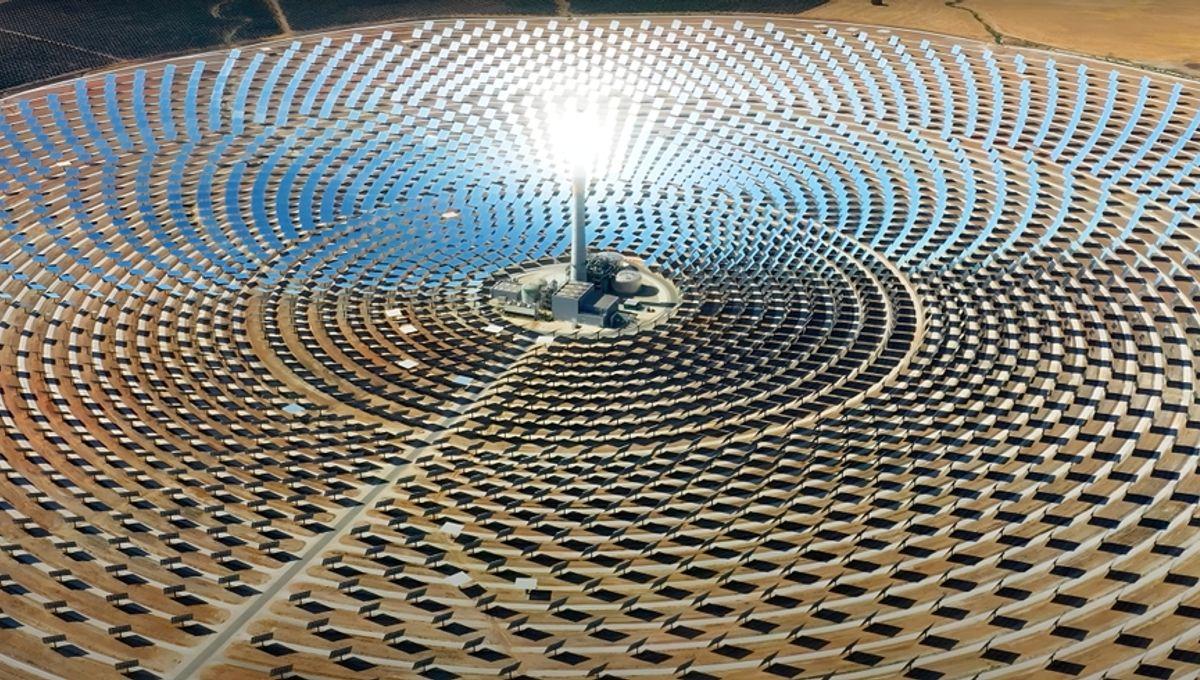Mirrors that focus sunlight to produce electricity have been vastly outpaced by photovoltaic panels, but one scientist thinks they could have a second application, spotting asteroids at night.
Solar thermal power has a great advantage over solar panels on roofs or in most solar farms: it can continue to produce electricity after the Sun has gone down. The mirrors known as heliostats at solar thermal facilities focus sunlight to heat fluids to very high temperatures to drive turbines. The more common version involves fields of heliostats reflecting light on a central tower through which the fluids move. The materials stay hot enough to continue spinning the turbines after dark, depending on the fluid and the turbine sometimes all night. That advantage has not been sufficient to allow solar thermal to compete commercially with photovoltaics’ lower price and flexibility of location, although there are reasons to think that may change. However, while the turbines keep working at night, the mirrors don’t, which is something Dr John Sandusky of Sandia National Labs wants to change. “The heliostat fields don’t have a night job. They just sit there unused. The nation has an opportunity to give them a night job at a relatively low cost for finding near-Earth objects,” Sandusky told the Sandia newsletter LabNews. “If we knew ahead of time that an asteroid was coming and where it might hit, we’d have a better chance to prepare and reduce the potential damage.” Sandusky's first test of the idea was conducted with just one of the 212 heliostats at the National Solar Thermal Test Facility. Using software already built to move the heliostat in daylight, he had it sweep backwards and forwards around once a minute and collected the light it focused on the tower. Current asteroid-hunting techniques produce images of areas of the sky tracked to follow the apparent motion of the stars. Asteroids, or anything else, moving relative to the stars, show up as streaks that computers can recognize. We’ve become a lot better at detecting objects moving through the inner Solar System in recent years, which is why all three interstellar visitors we have detected have been since 2017. We already know the Vera C Rubin Observatory can take it up a notch further. Nevertheless, there is still room for further improvement, since we lack the capacity to watch the whole sky at once. Moreover, if we had a different method for finding objects like this, the giant telescopes currently used for the purpose could be redeployed to research roles. Sandusky anticipates that the relative motion of an asteroid compared to the stars will lead to a detection when the light of one is reflected off the heliostat. “Solar towers collect a million watts of sunlight,” Sandusky said. “At night, we want to collect a femtowatt, which is a millionth of a billionth of a watt of power of sunlight that’s scattered off of asteroids.” Sandusky’s test run using the single heliostat did not find an asteroid, but he didn’t really expect it would. Instead, he wanted to prove it could be moved at the appropriate rate and reflect starlight to the instruments, and he has claimed success. He presented the results to a conference last year and published a paper, but is now seeking wider input on whether the idea has potential and how his proposed approach could improve. “We want to hear from our peers in optics and the asteroid hunting community,” Sandusky said. “Getting peer feedback provides an opportunity to understand what the concerns are about how this technology will work.” Ironically, the basis for this idea comes from a question Sandusky was asked twenty years ago about the potential to use heliostats for imaging. “No. They’re not high enough optical quality to form an image,” he replied at the time. Nevertheless, the question lingered and it occurred to him there were parallels between the reflections of an object moving relative to the stars and frequency shifts used in radio communication. “We have very precise methods for measuring frequency,” Sandusky said. “Even frequency changes as small as one-one-millionth of one cycle per second are measurable thanks to frequency standards that can be commercially procured and locked to references like GPS signaling. I knew it was possible to measure the very small rate differences of an asteroid passing relative to the stars.” “If I can map all of the stars to one frequency, anything moving relative to the stars will appear at a neighboring frequency but still be separable,” he concluded. Having demonstrated the precise speed control required is possible, and that heliostats can reflect the stars, he’s ready to move on to try to find asteroids. A stepping stone would be to have the heliostat reflect a part of the sky where a bright suitable object is known to pass, to see if it can be found this way. From there, one could chase smaller known objects, and eventually seek those not yet known. Sandusky also has ideas for related tasks that could expand heliostats' nighttime uses, such as for detecting lost spacecraft, particularly orbiting between Earth and Moon, such as the one that hit the Moon in 2022. “Orbits near the moon can be difficult to track from the ground,” he said. It’s unlikely there will be enough of a market to use heliostats in this way to substantially shift the economics of solar thermal projects when competing against other sources of energy, but every little bit helps. The idea was published in Unconventional Imaging, Sensing and Adaptive Optics, as part of the proceedings of the Optical Engineering and Applications conference.





